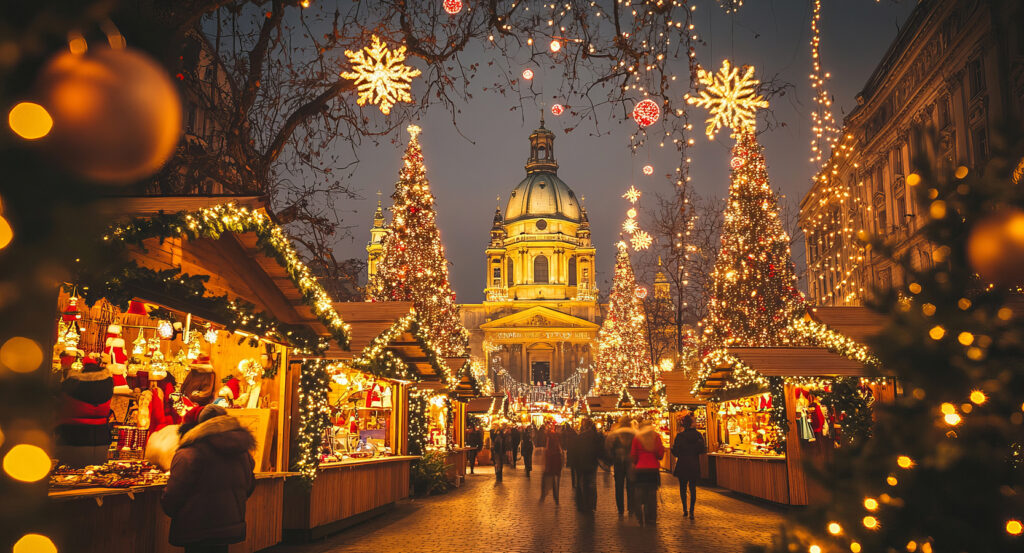
Why you should experience St. Stephen’s Basilica in Budapest.
St. Stephen’s Basilica rises from the heart of Budapest as a vision of elegance, faith, and Hungarian pride, a sacred landmark that captures both the grandeur of Catholic tradition and the resilience of a nation reborn from centuries of transformation.
From the moment you step onto Szent István tér, the basilica’s twin bell towers frame the skyline, drawing the eye upward toward its majestic dome, a symbol of divine harmony and national unity. Inside, the air is perfumed with incense and whispers of prayer that echo beneath vaulted ceilings adorned with gold leaf and frescoes depicting scenes from Hungarian spiritual history. The central nave, bathed in a warm, amber glow, leads to the high altar where the mummified right hand of St. Stephen, Hungary’s first king and patron saint, rests in a crystal reliquary, a holy relic that connects the modern nation to its medieval roots. It’s a place where faith feels tangible, as if each pillar and painting holds the heartbeat of Budapest itself. Climbing to the observation deck offers a different form of reverence, a panoramic view of the city that reveals the Danube snaking through the center, bridges gleaming in the sunlight, and the Parliament building standing majestically across the river. It’s a moment that transcends architecture, a fusion of spirit, stone, and sky.
What you didn’t know about St. Stephen’s Basilica.
Though it feels eternal, St. Stephen’s Basilica is a testament to human tenacity and craftsmanship, a work that took more than five decades to complete.
Construction began in 1851 under the guidance of architect József Hild, whose vision was interrupted by his death and later by the collapse of the partially built dome in 1868. It was Miklós Ybl, the architect behind Budapest’s Opera House, who redesigned and restored the project, balancing Neoclassical harmony with Renaissance ornamentation. When it was finally completed in 1905, the basilica was dedicated not only to its namesake saint but to the resilience of the Hungarian people themselves. Every stone, every arch, feels like a prayer for continuity. Its bells are among the largest in Hungary, and their echo across the city is deeply symbolic, a call not just to worship but to remember. Inside, the paintings of Károly Lotz and Gyula Benczúr adorn the cupola and chapels with a radiance that feels alive even a century later. The basilica’s height of 96 meters, shared only with the Parliament Building, is no accident; it signifies the balance between spiritual and secular power in Hungary, reminding visitors that both serve the nation’s soul. Perhaps most striking is the building’s modern afterlife, home to symphonic concerts, holiday performances, and public ceremonies that weave culture into faith, keeping it as relevant to Budapest today as it was a century ago.
How to fold St. Stephen’s Basilica into your trip.
Visiting St. Stephen’s Basilica is not just a cultural stop, it’s a moment to pause and breathe amid Budapest’s rhythmic energy.
Start your visit early in the morning, when sunlight spills through the western windows and casts a gentle aura across the marble floor. Attend a midday mass if you can; even if you’re not religious, the choral music and acoustics create a soothing grandeur that words can’t describe. Afterward, climb the cupola’s spiral stairs or take the elevator to the observation deck, a reward that unveils Budapest’s beauty in every direction. From there, wander down to the square outside, lined with cafés and street musicians, where you can sip a coffee while the basilica’s façade glows in gold and stone. If you’re in Budapest during winter, return after sunset, the Christmas market fills the plaza with lights, mulled wine, and choirs singing beneath the towering dome. Nearby, you’ll find Andrássy Avenue and the Hungarian State Opera House within walking distance, making this part of the city a natural starting point for a day of exploration. Before you leave, step back once more and take in the basilica’s symmetric form, a masterpiece that embodies the balance between heaven and earth, faith and art, past and present. St. Stephen’s Basilica is more than Budapest’s crowning jewel; it’s the heartbeat of a city that has never stopped believing in its own beauty.
Hear it from the Foresyte community.
You think you’ve seen churches and then this one drops a mummified king’s hand and a rooftop view that goes forever. Didn’t see that one coming.
Where meaningful travel begins.
Start your journey with Foresyte, where the planning is part of the magic.
Discover the experiences that matter most.






































































































